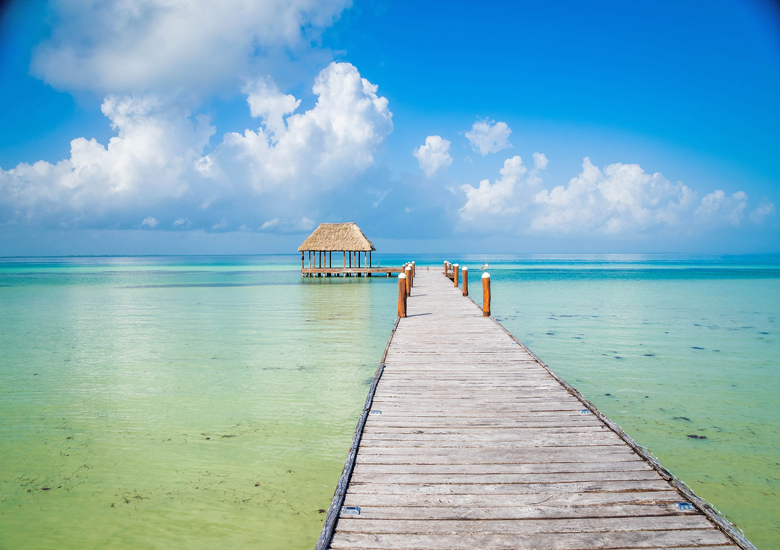Holbox (“black hole” in Yucatec Maya) is an island in the Mexican state of Quintana Roo, located on the north coast of the Yucatan Peninsula. It is approximately 41.84 kilometres (26.00 miles) long and 1.5 kilometres (0.9 miles) wide, and it is separated from the mainland by 10 km of shallow lagoon that is home to flamingos, pelicans and other rich birdlife. Holbox Island is part of the Municipality of Lazaro Cardenas and also part of the Yum-Balam Biosphere Reserve.
Not yet heavily touristed, the island’s main industry is fishing. However, the island is developing a growing tourist industry in the form of whale shark viewing. Lobster is the main product of this fishing, and many of the dishes made on the island center around lobster or other seafood. The island is accessed by ferry from the mainland town of Chiquila, and has virtually no cars, with transport by most residents and tourists by golf cart or moped. A small airline, Flights Holbox , Aerosaab, flies tours to Holbox from Cancun and Playa del Carmen; there is even a small airstrip to accommodate five-seater, 13 seater Cessna aircraft. used.
The entrance of vehicles is not allowed at Holbox in order to protect the environment and to prevent the streets from getting sand. Holbox has several alternatives to enjoy nature, but the one that attracts most visitors is the experience of swimming with the impressive whale shark from June to September, an opportunity you can experience in very few parts of the world. During hurricane season, the island is often evacuated as it can get directly damaged by hurricane winds.
History : The first mentions of the island were in 1852 from a document sent by Don Bartolome Magana to the Governor of Yucatan. The adjacent mainland was frequently attacked by the Maya therefore people sought refuge on this island. The government wanted to keep people from living on this island but the citizens refused to leave their homes. Hurricanes in 1886 completely destroyed the island, but the island was rebuilt following.
acces By ferry : From Chiquila. There are two companies that operate from the dock, very similar boats, similar prices, and leaves at the same time. Take your pick. Costs M$140 (one-way) and runs daily at 06:00, 08:00, 10:00, 11:00, 12:00, 13:00, 14:00, 16:00, 17:00, 19:00, and 21:30. On weekends it also runs at 15:00 and 18:00. It takes about 25-30 minutes. With two or more people you can charter a fisher’s boat for the same price.
By bus : There are three buses daily from Cancun to Chiquila and back on Mayab and Oriente. They leave from the main Cancun ADO terminal at 7:40 am, 9:40am, and 12:50 pm (as of Apr 2017) and the price is MXN125 per person. On Mayab (the first two) there is no luggage storage under the bus, and you’ll need to take it aboard. The bus may or may not be full so there may be a chance to place your luggage in an empty seat, however, that is not always guaranteed. The bus takes between 2 hours 40 minutes to 3 hours.
From Merida you can take a night bus at 23:30, arriving in Chiquila at 05:30, passing Valladolid around 02:30. If you prefer traveling during the day, you can take a bus from Merida or Valladolid to Tizimin and change there to a bus to Chiquila.
Get around : The island of Holbox is very small and there are no paved roads, only sandy paths. There are very few cars on the island and most people get around by walking, bicycle, or golf cart.
activities : Swim with the whale shark , Flamingo and bird watching , Kayak in the crystal waters , Fishing with the islanders , Visit the Chichen Itza archeological site ( UNESCO World Heritage Site and in 2007 ), Kiteboarding in Holbox .Holbox has one of the safest beaches for learning how to kiteboard. Conditions are ideal for beginners, as the beach has shallow waters, no big obstacles on the wide and long beach, many days of wind during the winter months, and a nearby school with professional instructors. Advanced riders can find also very good conditions when the north or south winds reach 25 knots or more. The climate is subhumid warm, creating a stable and consistent temperature year-round.

